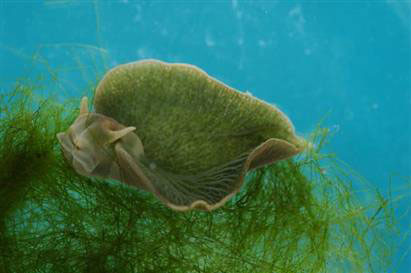Sea slug: Calling is a child or a tree?
For the first time, scientists have discovered something that has never been seen in nature: a species of sea slug is both an animal like a human but has the ability to synthesize chlorophyll (chlorophyl) - the basic function of plants. .

This is a green, half-animal, half-plant, sea slug that produces chlorophyl to carry out photosynthesis, turning light into energy.
The green sea slugs seem to stealthily steal the seaweed's synthetic chlorophyll gene that they often eat. With this 'borrowed' gene, they have achieved the photosynthesis process that plants use to turn sunlight into energy.
Professor Sidney Pierce, a famous biologist from the University of South Florrida, said: "This sea slug can create energetic molecules to live without eating or drinking."
Prof. Pierce has studied the species very nicely, with the scientific name of Elysia chlorotica for 20 years. He presented his important findings at the recent Biology Society meeting in Seattle and published in Science News.
"This is the first time people have seen a multicellular animal that can produce chlorophyll ," Pierce said.
Sea slugs live in saltwater swamps in Canada and New England. Along with stealing genes to synthesize blue pigments, the snail-sniffs also steal tiny cells called chloroplast that control photosynthesis, converting sunlight into energy, like plants did, so that they don't need to eat but still get energy.
"We caught them and kept them in the tank without feeding them for months, but they were still living normally, just shining sun rays on them 12 hours a day," Pierce said.
Researchers used radioactive oils to make sure these slugs actually produced chlorophyl rather than "steal" the color that the algae had "prepared".
The offspring of the interstitial snail were transferred to the chlorophyl self-synthesis ability of their parents, but photosynthesis had not yet been achieved until they had eaten a sufficient amount of algae to steal the necessary chloroplasts. because they are not capable of producing this substance.
Slugs have made a spectacular "slack", but scientists are still confused, not understanding how they do this to 'install' a very different piece of gene into their bodies.
Professor Pierce is very reserved: 'It is possible that DNA can be transferred naturally from one species to another, but according to which mechanism we have not yet figured it out'.
- Giant carnivorous slug invades Britain
- Unique 'sea slug species' of a single use
- Beautiful sea slug species in the ocean
- The explorer is as flexible as the sea slug
- North America has a giant purple sea slug resembling human organs
- Sea slug is the same as Pikachu that causes fever in Japan
- How slug becoming self defence?
- The oldest tree in England has changed sex after 3,000 years
- Facebook opens the video calling feature globally
- Synthesis of the best video calling software on Android
- The city loses sleep because of fish calling for mates
- Saliva of the slug does all the pain
 Surprised: Fish that live in the dark ocean still see colors
Surprised: Fish that live in the dark ocean still see colors Japan suddenly caught the creature that caused the earthquake in the legend
Japan suddenly caught the creature that caused the earthquake in the legend A series of gray whale carcasses washed ashore on California's coast
A series of gray whale carcasses washed ashore on California's coast Compare the size of shark species in the world
Compare the size of shark species in the world